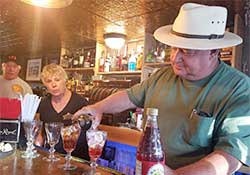
by Gage T. Smith, “the Picon Guy”
I guess it is an age related thing but I am finding that in my travels, what was supposed to be the focus of the trip gets relegated back and a new interest takes its place.
On a recent week-long trip to the southern end of the Reese River Valley, my intent was to thoroughly explore some of the unknown canyons on either side to the valley. The Toiyabe Mountains on the east side of the valley do contain some interesting side canyons, the Shoshone Mountains on the west side were equally, if not more, dramatic in the rock formations and such.
But what caught my fleeting attention this trip is architecture. Running the length of the Reese River Valley is State Route 21, one of Nevada’s finest dirt roads, a well maintained 60 mph road (provided your tires are in decent shape).
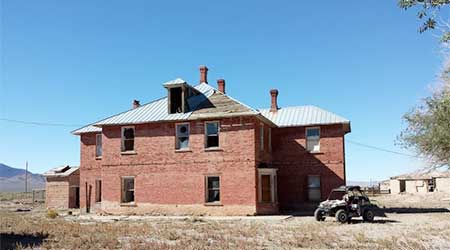 Scattered along this stretch of road are some four elegant brick houses dating back to the late 1800s and early 1900s. These fine homes were made entirely of red brick freighted down Reese River Valley from Austin. Having buildings of this size and scope are indicative of how prosperous agriculture in the Reese River Valley really was.
Scattered along this stretch of road are some four elegant brick houses dating back to the late 1800s and early 1900s. These fine homes were made entirely of red brick freighted down Reese River Valley from Austin. Having buildings of this size and scope are indicative of how prosperous agriculture in the Reese River Valley really was.
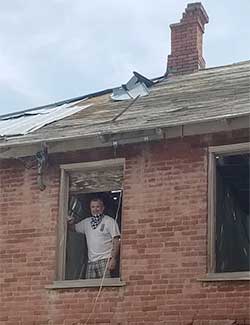 The Hess Ranch is a rather large two story house built in the late 1860s by German immigrant Jacob Hess. The Hess ranch house is in total disrepair and its days may be numbered. The roof is off or flapping in the wind. The windows are gone and the doors are all opened. It’s a junk heap inside. I wish I had better things to say about it.
The Hess Ranch is a rather large two story house built in the late 1860s by German immigrant Jacob Hess. The Hess ranch house is in total disrepair and its days may be numbered. The roof is off or flapping in the wind. The windows are gone and the doors are all opened. It’s a junk heap inside. I wish I had better things to say about it.
I wrote a rather extensive story about in for my Picon Drinkers of the American West page on June 8th if you would like to read more. Probably the most interesting part is the comments of people who lived there, worked there or had relatives who did.
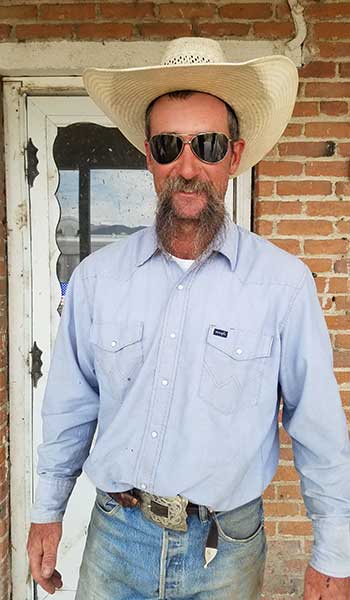 The next brick house to the south is owned by the Reese River Livestock Company and sits on what was known as the “O’Toole Ranch”. Things are looking up for this old house started in 1902 and finished in 1904.
The next brick house to the south is owned by the Reese River Livestock Company and sits on what was known as the “O’Toole Ranch”. Things are looking up for this old house started in 1902 and finished in 1904.
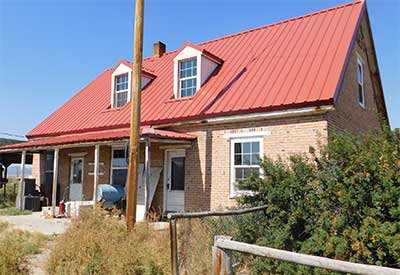 David Black (pictured) is the new owner of this ranch and has grand plans for the old structure. First off, he put in a new roof and fixed all the broken windows and doors so it is now weather tight. David gave me a tour of the old place and I can say this with certainty — he has his work cut out for him. All it takes is time and money with the latter being paramount. It’s a beautiful old place.
David Black (pictured) is the new owner of this ranch and has grand plans for the old structure. First off, he put in a new roof and fixed all the broken windows and doors so it is now weather tight. David gave me a tour of the old place and I can say this with certainty — he has his work cut out for him. All it takes is time and money with the latter being paramount. It’s a beautiful old place.
 Third on the list is located on the Yomba Indian Reservation a few more miles down the road. The reservation was created in the 1930’s for the Shoshone tribe of the area. Yomba means wild carrot which are plentiful in the Reese River Valley. I have found little on this house and have conversed with the tribe down there. There seems to be not much known of this old house other than it may have been housing for the teachers at the Yomba School in years past.
Third on the list is located on the Yomba Indian Reservation a few more miles down the road. The reservation was created in the 1930’s for the Shoshone tribe of the area. Yomba means wild carrot which are plentiful in the Reese River Valley. I have found little on this house and have conversed with the tribe down there. There seems to be not much known of this old house other than it may have been housing for the teachers at the Yomba School in years past.
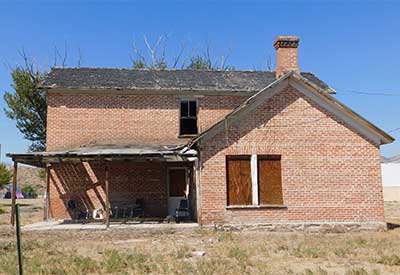 The Yomba Shoshone Reservation came into existence by proclamation on October 27th, 1938. This house was in existence well before that date. It was part of two ranches bought by the Federal Government for this reservation. The two ranches were the Bowler and the Doyle Ranches deeding over to the tribe about 4700 acres of land. This old house sits on the Doyle Ranch so I am making an assumption (always dangerous) that the Doyle family built the house but have no other proof.
The Yomba Shoshone Reservation came into existence by proclamation on October 27th, 1938. This house was in existence well before that date. It was part of two ranches bought by the Federal Government for this reservation. The two ranches were the Bowler and the Doyle Ranches deeding over to the tribe about 4700 acres of land. This old house sits on the Doyle Ranch so I am making an assumption (always dangerous) that the Doyle family built the house but have no other proof.
However, I do think that the house predates the reservation by a number of years.
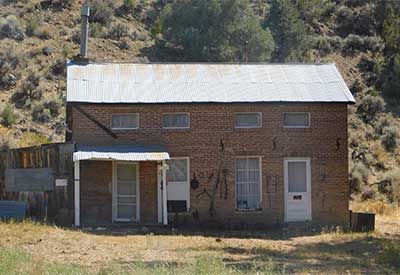 This was all a part of the Indian Reorganization Act of 1934. The purpose was to give the tribes a viable economic source that would allow them to thrive economically and still remain as a tribal group.
This was all a part of the Indian Reorganization Act of 1934. The purpose was to give the tribes a viable economic source that would allow them to thrive economically and still remain as a tribal group.
The fourth house is in Ione. It maybe not be in the Reese River Valley but close enough to be included in this dispatch. I’ve looked for any information that I can find on this house and have come up with nothing other than the picture. However, Ione in its quietness and its tree shaded canyon is worth a visit . . . even if you enjoy your lunch in the “City Park” or on the bench in front of the now closed Ore House Saloon.
Plus, it is just a hop skip and a jump past Ione to Berlin-Icthyausaur State Park.
Picon Map of Nevada Route 21
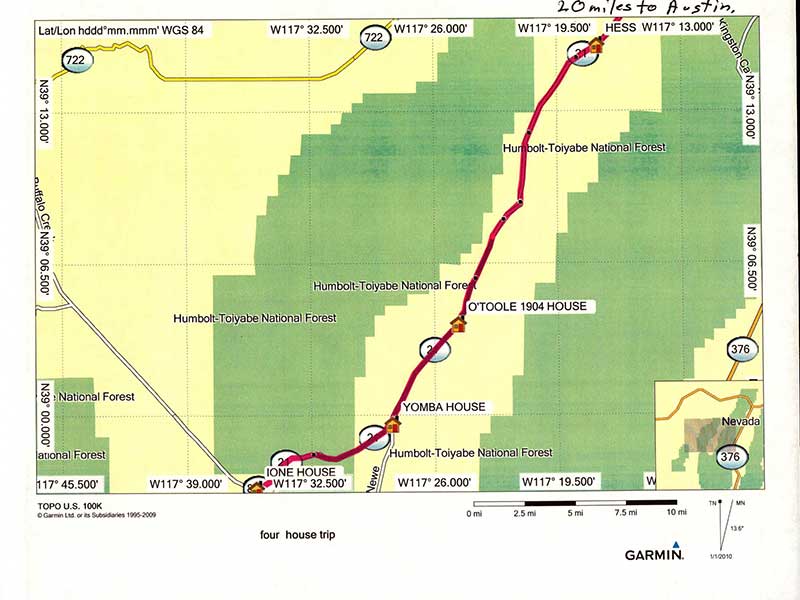



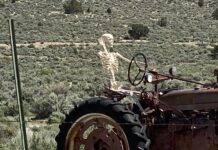
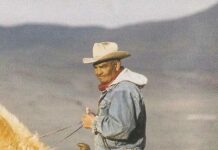
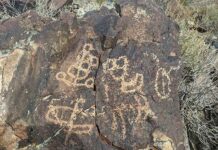
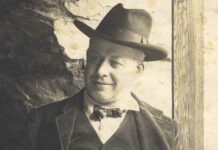
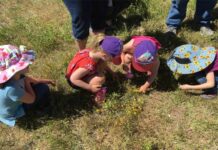
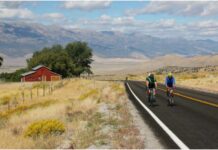






I know where my next road trip is. Nice article.
The “white ranch” in Reese River Valley is the old “CCC” civilian conservation camp facility from the 1930’s. I worked there from ’70-73 when it was the Reese River Ranger Station on the Toiyabe NF, managed out of Fallon, Nevada at the time. Pete Pierson was the district ranger. I was the range conservationist and Johnny Lytle was the district assistant and fire tech. Steve Vicks (later to be a medical doctor in Fallon) was on the fence crew that worked on the Knox Creek seeding and Washington allotment projects. Jim Champey was the manager of the Toiyable Cattle Company at the time. Bartley O’Toole rented us his tractor to pull the rangeland drill for the seeding. The ranger station was given to the Yomba Tribe in the 1980’s due to budget cuts and was then abandoned. It breaks my heart to see it’s condition now. We had the place looking good with fresh green lawns around the house, horses in the pasture, bright white paint on the buildings. A real “oasis” in the desert. The high desert museum moved the office building to their property in Bend, Oregon a few years ago. Me and my wife visited it recently. Great memories and thanks for the photos.
Hey Lynn,
I worked with the US Forest Service road maintenance crew in the Summer of 1972 out of Reno. Bob Thompson was the Reno-based maintenance chief. He hired me right out of high school. Dave Devore was the crew boss. Other crew members were Al Butterfield, George Powell and Gary Mittleider. I remember there was a family of four that lived in the home, with two young boys. Was that your family? I remember how nice the place was with the neat and fresh green lawns. And I remember you grilling some steaks for the crew one time over mountain mahogany. All the buildings were well maintained. Like you say, it is heartbreaking to see it now.
Did you know marsden hopkins in 1971..he worked for toiyabe cattle company..was killed Sept 6 1971..west of austin..returning to the ranch from fallon…we were best friends..grew up in south dakota…Duane gordon
The large two story main brick house was built in 1920’s by Patrick Walsh, not Jacob Hess.
Jacob hess built the out buildings
Reply to Lynn Williams,
Lynn, I worked at the Reese River Ranger Station in the Summer of 1972, just after high school graduation. I worked on a USFS road maintenance crew with Dave Devore, Gary Mittleder, Al Butterfield and George Powell. There was a family that lived there during the summer months. As I recall it was comprised of a married couple and two young boys. Was that you who lived at the small house in front of the ranger office?